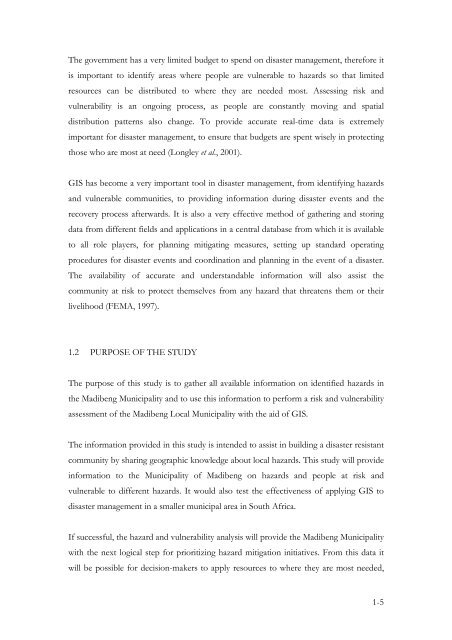A spatial multi-risk hazard assessment and vulnerability study of ...
A spatial multi-risk hazard assessment and vulnerability study of ...
A spatial multi-risk hazard assessment and vulnerability study of ...
You also want an ePaper? Increase the reach of your titles
YUMPU automatically turns print PDFs into web optimized ePapers that Google loves.
The government has a very limited budget to spend on disaster management, therefore it<br />
is important to identify areas where people are vulnerable to <strong>hazard</strong>s so that limited<br />
resources can be distributed to where they are needed most. Assessing <strong>risk</strong> <strong>and</strong><br />
<strong>vulnerability</strong> is an ongoing process, as people are constantly moving <strong>and</strong> <strong>spatial</strong><br />
distribution patterns also change. To provide accurate real-time data is extremely<br />
important for disaster management, to ensure that budgets are spent wisely in protecting<br />
those who are most at need (Longley et al., 2001).<br />
GIS has become a very important tool in disaster management, from identifying <strong>hazard</strong>s<br />
<strong>and</strong> vulnerable communities, to providing information during disaster events <strong>and</strong> the<br />
recovery process afterwards. It is also a very effective method <strong>of</strong> gathering <strong>and</strong> storing<br />
data from different fields <strong>and</strong> applications in a central database from which it is available<br />
to all role players, for planning mitigating measures, setting up st<strong>and</strong>ard operating<br />
procedures for disaster events <strong>and</strong> coordination <strong>and</strong> planning in the event <strong>of</strong> a disaster.<br />
The availability <strong>of</strong> accurate <strong>and</strong> underst<strong>and</strong>able information will also assist the<br />
community at <strong>risk</strong> to protect themselves from any <strong>hazard</strong> that threatens them or their<br />
livelihood (FEMA, 1997).<br />
1.2 PURPOSE OF THE STUDY<br />
The purpose <strong>of</strong> this <strong>study</strong> is to gather all available information on identified <strong>hazard</strong>s in<br />
the Madibeng Municipality <strong>and</strong> to use this information to perform a <strong>risk</strong> <strong>and</strong> <strong>vulnerability</strong><br />
<strong>assessment</strong> <strong>of</strong> the Madibeng Local Municipality with the aid <strong>of</strong> GIS.<br />
The information provided in this <strong>study</strong> is intended to assist in building a disaster resistant<br />
community by sharing geographic knowledge about local <strong>hazard</strong>s. This <strong>study</strong> will provide<br />
information to the Municipality <strong>of</strong> Madibeng on <strong>hazard</strong>s <strong>and</strong> people at <strong>risk</strong> <strong>and</strong><br />
vulnerable to different <strong>hazard</strong>s. It would also test the effectiveness <strong>of</strong> applying GIS to<br />
disaster management in a smaller municipal area in South Africa.<br />
If successful, the <strong>hazard</strong> <strong>and</strong> <strong>vulnerability</strong> analysis will provide the Madibeng Municipality<br />
with the next logical step for prioritizing <strong>hazard</strong> mitigation initiatives. From this data it<br />
will be possible for decision-makers to apply resources to where they are most needed,<br />
1-5
















